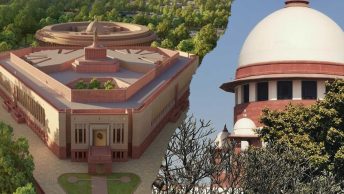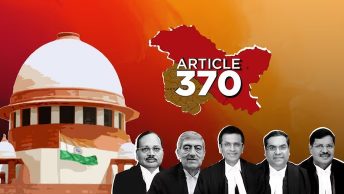This post is the second part of a three part series deconstructing the Sabrimala Verdict which opened the gates of temple to women devotees. You may find the first post here and third post here.
The piece mainly deals with the issues relating to religious freedoms under Articles 25 and 26. A major clash in this case was whether the devotees constitute a separate religious denomination under Article 26. If the above was answered in the affirmative, the right under Article 26, to manage their own religious affairs would be in conflict with two aspects of Article 25. First, it would be in conflict with Article 25(2) which protect laws opening up access of public religious institutions and second, with women’s right to worship under Article 25 (1). If the devotees did not constitute a separate religious denomination and if exclusion of women is an essential religious practice, both the above-mentioned aspects of Article 25 would be in clash the group right of devotees under Article 25, to profess and practice their religion (if the court recognized the existence of such a group right under Article 25).
- If the devotees formed a religious denomination, how is the clash between Article 25(2) and Article 26 resolved?
As per J Malhotra, the prohibition was valid as per the proviso of Section 3 of the The Kerala Hindu Place of Public Worship (Authorisation of Entry) Act, 1965 (herein referred to as the Act), hence there was no clash between the laws framed under Article 25(2) and Article 26. As the majority held that the devotees are not a religious denomination for the purpose of Article 26, this clash did not arise. Yet, it was dealt with in the opinions of J Nariman and J Chandrachud.
J Nariman after looking at a slew of precedents, concluded that since the fundamental rights are to be harmoniously constructed, the Article 26 right would be subject to the laws made under Article 25(2) which throw open religious institutions (para 21.13). However, any practice that did not completely ban entry or is not discriminatory would be valid under Article 26 (para 12.14). J Chandrachud’s cited Venkataramana Devaru case in which the court applied harmonious construction and said that if Article 26 allowed no exceptions or was not subject to Article 25(2), then the protection under Article 25(2) would be redundant (para 31). Hence, as per both these judges, if there is clash between the two, Article 26 did not override the protection under Article 25(2), but instead is subjected to the same.
- The court’s interpretation of the right to worship under Article 25
The majority held that the freedom to practice and propagate religion is available to everyone on two grounds. First, it focused on the the phrase ‘all persons’ in Article 25 to show the universal nature of the right (J Misra para 98, J Nariman para 21.1 and J Chandrachud para 6). Second, it observed that the Article 25 right has an element of non-discrimination as all persons are ‘equally entitled’ to the right. (J Misra para 101, J Nariman para 21.2, J Chandrachud para 6). J Misra also observed that the Article 25 right is not only about interfaith parity but about intra-faith parity (para 101). Furthermore, J Misra (para 99) and J Chandrachud (para 6) viewed the right to be enjoyed by individuals, whereas J Nariman (para 21.5) and J Malhotra (para 7.5, para 10,1) viewed it a right available to both individuals and communities (para 21.5). The majority concluded that the prohibition on entry violates women’s right under Article 25 (1). (J Misra para 101, J Nariman para 30). Though J Chandrachud, did not explicitly mention this, but recognized it when he compared exclusion of worship to denial of dignity (para 15).
J Malhotra recognized that the Article 25 right is available to each person, however, according to her, the right is subject to the tenets of that faith or shrine and could only be claimed by devotees of that faith. In other words, “If a person claims to have faith in a certain deity, the same has to be articulated in accordance with the tenets of that faith” (para 7.5). Hence, the right claimed had to be based on the affirmation of a belief in the particular manifestation of the deity (para 7.2).
- The court’s interpretation of the word ‘Morality’ to which Articles 25 and 26 are subjected.
All four judges except J Nariman agreed that the term morality should be interpreted as ‘constitutional morality.’ Rejecting this interpretation, J Nariman reasoned that doing so would indirectly bring in other provisions of Part III which Article 26 is not subject to (Pg. 53, footnote 2). He instead viewed morality as something that is “considered abhorrent to civilized society, given the mores of the time, by reason of harm caused by way, inter alia, of exploitation or degradation” (para 21.7), however, he does not use this definition for any further analysis.
J Misra observed that morality could not be narrowly viewed from perspective of an individual, section or religious sect and that it must be in conformity with basic tenets of the Constitution (para 105). He only used this term in the specific context of Article 25 (though one could argue that it could also be used in context of Article 26, since the term used there is the same) and concluded that morality could not be used as a colourable way to restrict women’s right and that public morality has to yield to constitutional morality (para 111). However, he simply asserted the above without analysing the reasons for arriving at this conclusion. This is problematic considering that J Malhotra arrived at an entirely opposite conclusion using the same term.
J Chandrachud reasoned about why constitutional morality should be preferred over societal morality. First, popular notions of morality are transient and morality for constitutional interpretation could not have an ephemeral existence. Second, popular and arbitrary notions of morality could not be used to curtail individual rights. (para 11). According to him, the purpose of the Constitution is to ensure a wider acceptance of human dignity and liberty. Hence, constitutional morality must be deeply rooted in principles found in the preamble of human liberty, equality, fraternity and dignity, as they are means for individuals to secure justice. Therefore, in case of a conflict, human dignity, equality and liberty should prevail over religious beliefs and faiths. (para 12)
J Malhotra did not justify why morality should be interpreted as constitutional morality and directly analysed its interpretation. She defined the term as “moral values underpinning the text of the constitution” which help ascertain the true meaning of the Constitution and help achieve its objectives (para 11.5). She also recognized equality and non-discrimination to be a facet of constitutional morality, however, held that cherished liberties of faith, belief and worship should also be protected. She concluded that constitutional morality required balancing such rights, and to ensure that religious beliefs of none are undermined (para 11.8) without offering a clear justification for tilting in favour of religious beliefs in comparison to principles of equality and non-discrimination.
- Whether exclusion of women constituted an Essential Practice?
J Misra and J Chandrachud both answered the question in negative. J Misra observed that since devotees of Sabrimala are not a religious denomination, whether the practice is essential or not has to be judged on tenets of Hinduism (para 112). He concluded that there is no spiritual or textual evidence to prove that the exclusion is an essential practice of Hinduism (para 122). He later also delved into the issue of whether the practice is essential in the particular context of Sabarimala. Both him and J Chandrachud, emphasized on the fact that on previous occasions, women between 10-50 years were allowed to enter the temple and hence, without continuity, a practice/ custom could not be termed as an essential practice. (J Misra para 125, 126 and J Chandrachud para 51). In addition to this, J Chandrachud also relied on the fact that in earlier days, the prohibition was based on non-religious reasons (physiological reasons- women not being able to complete the journey because of it being arduous). Due to this, the claim failed to fulfil the requirement that the practice is to be on strictly religious ground, and instead it seemed to be based on stereotyping the women of being a weaker gender (para 53).
J Nariman did not deem it necessary to delve into this question, and proceeded with the assumption that it is an essential practice (para 25). He held that despite it being an essential practice, the prohibition on entry is unconstitutional. The reason being, essential practices are protected under Article 25(1), but the rights in that article are subject to the laws made under Article 25(2) (para 28).
As per J Malhotra, the exclusion of women between 10 to 50 years, is an Essential Religious Practice. She relied on the finding of the High Court decision, which were based on the testimonies of 3 witnesses that had direct and personal knowledge about the temple practices. The 3 witnesses testified that the exclusion was followed since several centuries because the deity in Sabrimala is in the form of a ‘Naishtik Bhramachari’ i.e. celibate. Based on this the High Court concluded that the custom is followed since time immemorial, and she observed that findings of fact ought not to be opened in an Article 32 petition, as res judicata would apply against the HC decision (para 13.8). Additionally, she also relied on the evidence of these practices that were found in memoir of survey of Tranvancore and Cochin State (para 13.12). She finally concluded that the practice had been followed since time immemorial to preserve the manifestation of the deity and any interference would impact the character of the temple and beliefs of the worshippers. Hence, the practice is an Essential Practice (para 13.13).
Conclusion
The issue of whether exclusion was an Essential Religious Practice, is of great significance. If it was recognized as an Essential Religious Practice, the exclusion of women would be protected by devotees right under Article 25. Thereafter, the court could only prohibit the ban based on violation of any other fundamental right, since the language of Article 25 clearly subjects it to other fundamental rights.





